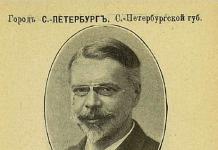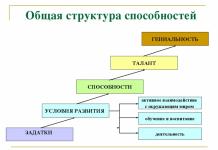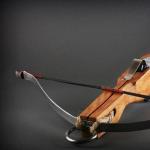Girt, German anthropologist and surgeon. Born April 29, 1898 in Mannheim. After receiving his medical degree, he taught for some time in Heidelberg. After meeting Himmler in 1936, Hirt joined the SS in 1939 with the rank of Hauptsturmführer (captain). Himmler set him the task of finding an antidote to mustard gas. Hirt experimented on dogs and himself, after which he ended up in the hospital with a severe hemorrhage in the lungs. Subsequently, he began conducting experiments on concentration camp prisoners, many of whom became blind or died. Himmler, as president of the Ahnenerbe Society, sought to achieve a “scientific justification” for his own racial theories. To do this, he appointed Hirt as head of the established Anatomical Institute at the University of Strasbourg. To collect the skulls, Hirt established close contacts with the “suppliers of raw materials” - Joseph Kramer, known as the “Beast of Belsen”, and Wolfram Sievers, the manager of the affairs of the Ahnenerbe society. On February 9, 1942, Hirt wrote to Himmler: “By properly providing the skulls of the Jewish-Bolshevik commissars, who are the prototype of the disgusting but characteristic subhuman, we have the opportunity to achieve certain scientific results. After a violent death, the head of a Jew, which should not be damaged, should be separated from the body and place in a hermetically sealed vessel filled with a preservative." When American and French troops approached Strasbourg in the summer of 1944, Hirt asked Himmler what to do with his collection of skulls. Himmler advised to destroy it. However, the allies discovered a pile of headless bodies in the storage room of Hirt's laboratory. Hirt himself disappeared and was nowhere to be found.
View value Hirt, August in other dictionaries
August- m. name of the eighth month of the year, old. sickle, roar; Vlad. Gustar, they eat everything abundantly and thickly. skiy, August, August, related to August. In August - sickles......
Dahl's Explanatory Dictionary
August- August, m. (Latin augustus). Eighth month of the calendar year.
Ushakov's Explanatory Dictionary
August M.— 1. The name of the eighth month of the calendar year.
Explanatory Dictionary by Efremova
August- -A; m. [lat. Augustus]. The eighth month of the calendar year, the last month of summer. Rainy a. First of August. Salary for a. Weather forecast for a.
◁ Augustovsky, -aya, -oe. A. day.........
Kuznetsov's Explanatory Dictionary
August- (63 BC - 14 AD) - Roman emperor, stepson of Julius Caesar. The reign of A is considered the most righteous and blessed in the entire history of the Roman Empire. His reforms improved......
Political dictionary
Hayek Friedrich August Von (1899-1992)— - Austrian economist and political philosopher. Nobel Prize winner in economics. Hayek's book "The Road to Serfdom" (1944) linked the genesis of totalitarianism........
Political dictionary
Schlegel August Wilhelm— (1767–1845) – German literary historian, critic, translator and poet. Like his brother F. Schlegel, A. Schlegel, a leading theoretician of romanticism, was the first to give a systematic exposition......
Political dictionary
Hayek Friedrich August (1899-1992)- English
economist,
representative of the neo-Austrian school. Basic
works: “The Road to Slavery” (1944), “The Road to Freedom” (1985). Hayek in his
anticipated works......
Economic dictionary
Schlozer Christian August (1774-1831)- German economist, author of the textbook “The First Principles of Commercial Science Taken in Its Own Meaning” (1816). In this work, for the first time, economic theory was linked with........
Economic dictionary
August- This name for the eighth month of the year comes from the Latin language, where the word "Augustus" was a male name meaning "sacred." The name was assigned by the Senate to the first Roman........
Krylov's etymological dictionary
August- (Augustus) (before 27 BC. Octavian) (63 BC - 14 AD) - Roman emperor from 27 BC. e. Great-nephew of Caesar, adopted by him in his will. Victory in 31 BC. e. at the Action over the Roman......
August II- (August) Strong (1670-1733) - Elector of Saxony (under the name of Frederick Augustus I) from 1694, King of Poland in 1697-1706, 1709-33. Participant in the Northern War of 1700-21 on the side of Russia.
Large encyclopedic dictionary
August III- (August) Frederick (1696-1763) - King of Poland and Elector of Saxony since 1733. Established on the throne as a result of the War of Polish Succession 1733-35. The reign of Augustus III is a time of political........
Large encyclopedic dictionary
Stanislav August- see Poniatovsky S.A.
Large encyclopedic dictionary
Hirt— (Hirt) Hermann (1865-1936) - German linguist, one of the representatives of neogrammatism. The main work "Indo-European grammar" (vol. 1-7, 1921-37).
Large encyclopedic dictionary
Abanus, August- Doctor of Philosophy, General Superintendent in Riga, writer; † 2-14 Oct. 1839
August- (Paul-Friedrich) - Grand Duke of Oldenburg, eldest son of Duke Peter-Friedrich-Ludwig and Princess Elizabeth of Württemberg; genus. July 13, 1783. After the occupation of Oldenburg........
Large biographical encyclopedia
August Albensky- Archimandrite 1798, ex. Pavlov. Ref. m.; † 1812
Large biographical encyclopedia
August Starkov— 1731-34 builder of Peshnoshsky
Large biographical encyclopedia
Augustus, Archimandrite of the Epiphany Monastery- in 1809-1829. Archimandrite of the Kostroma Epiphany Monastery, rector of the Kostroma Seminary, and in 1802-1809. - Abbot of Paisiin of Galicia
Large biographical encyclopedia
Augustus, Archimandrite of the Forerunner Monastery- in 1821-1828. Archimandrite of the Predtechev Monastery in
Large biographical encyclopedia
August, Hegumen of the Arkadyev Monastery- in 1840 hegumen of the Arkadyev Monastery, in
Large biographical encyclopedia
August, Abbot of the Ivan Old Ladoga Monastery- in 1748-1749 Abbot of Ivansky of Staro-Ladoga
Large biographical encyclopedia
August, Abbot of the Spaso-Sumorin Monastery- 2nd abbot of Vologda. Spaso-Sumorina m. from 1803, † 1807
Large biographical encyclopedia
August, False Tsarevich- - false prince, an impostor who appeared among the Cossacks on the Volga in 1609 and called himself the son of Tsar Ivan Vasilyevich the Terrible. The Cossacks captured him, brought him near Moscow, to Tushino,........
Large biographical encyclopedia
Adaridi, August-Karl-Mikhail Mikhailovich— - Major General of the General Staff, military leader and writer. Genus. August 29, 1859, a nobleman of the Vyborg province, was brought up at the Nikolaev Engineering School, but......
Large biographical encyclopedia
Albanus, August- (Albanus, Johann August Leberecht) - b. December 4 (new century) 1765 in Beuch, near Leipzig, died October 2, 1839 in Riga. In 1779 he went to the Livonia province as a home teacher, in 1792........
Large biographical encyclopedia
Albanus, August Adolfovich— - son of a pastor, b. in Dynamunde, near Riga, May 3, 1837, d. June 12, 1887, with the rank of Privy Councilor. Upon completion of the course at the Faculty of Medicine in Dorpat, with a degree........
Large biographical encyclopedia
Ahlquist, August Engelbert— - famous Finnish linguist; genus. 7 August 1826 in Kuopio, in Savolak; studied philosophical and philological subjects in Helsingfors and set as his task not only........
Large biographical encyclopedia
Apsesdals, August Apsit- - Latvian poet, began writing even before the revolution of 1905. A.’s poetic appearance was determined in the era of reaction under the influence of ten years of hard labor. Written behind the prison bars........
Large biographical encyclopedia
German anthropologist and anatomist, SS Sturmbannführer, head of the SS anatomical institute in Strasbourg, head of Ahnenerbe medical programs, war criminal.
August Hirt was born in 1898 in Mannheim into the family of a Swiss entrepreneur. Attended the Karl-Friedrich Gymnasium in Mannheim. In 1914, while still a high school student, he volunteered for the army. A participant in the First World War, in October 1916 he was wounded in the head. He received his medical education at the University of Heidelberg. In 1921 he received German citizenship.
In 1922 he defended his PhD thesis on the topic “The borderline trunk of the sympathicus in some dinosaurs”, in 1925 he defended his doctoral dissertation on the topic “On the direction of the fibers of the renal nerves”. He worked as a professor of anatomy. Since 1936, he was director of the anatomical institute of the University of Greifswald, in 1938 he moved to the same position in Frankfurt, and in 1941 he took up the post of director of the anatomical institute of the University of Strasbourg.
Activity as a war criminal
On April 1, 1933, Hirt joined the SS, and on May 1, 1937, he joined the NSDAP. He was personally acquainted with Heinrich Himmler. In 1939, he was seconded to the Berlin Military Medical Academy, where he studied the therapeutic effects of trypoflavin in cases of mustard gas. With the outbreak of World War II in the same year, he was drafted into the Wehrmacht and served as a senior military doctor.
In July 1942, with the formation of the Institute for Scientific Research for Military Purposes within the Ahnenerbe, Hirt occupied Department “H” (Hirt) there. To avoid repeated conscription into the Wehrmacht, he transferred to the SS troops. From March 1, 1942 - as part of the Personal Staff of the Reichsführer SS. Hirt conducted experiments with mustard gas on animals and on himself; as a result of one of the experiments, he himself ended up in the hospital with a hemorrhage in the lungs. After the outbreak of World War II, instead of animals, Hirt began using concentration camp prisoners in his experiments. In 1942-1943, according to the Natzweiler-Struthof concentration camp capo Ferdinand Hall, 150 people went through Hirt’s experiments, of whom 7 or 8 died, and the rest were sent to other concentration camps.
At the Anatomical Institute in Strasbourg, Hirt worked on the scientific substantiation of Nazi racial theories. The Institute worked in close cooperation with the Ahnenerbe Society. For his racial research, Hirt created an extensive anthropological collection of skeletons, skulls, and individual body fragments, which was later discovered by Allied forces in his laboratory's storage room. Auschwitz prisoners of various nationalities were used as “working material”.
After the war
After the liberation of Strasbourg, Hirt and his daughter fled from the advancing Allied troops to Tübingen in November 1944. He was hiding in the Black Forest under the guise of a peasant. He committed suicide (shot himself). However, his search continued until the end of the 1950s. In France, Hirt was sentenced to death in absentia in 1963.
Rate this article
Germany's entry into the war brought the anthropological research program to the forefront of Ahnenerbe's developments. This program was carried out by the Institute for Special Research in Military Sciences, which used living people as experimental material. One of the topics was developed by SS Hauptsturmführer Professor August Hirt from the University of Strasbourg. Hirt, German anthropologist and surgeon.
August Hirt the face of a maniac
Born April 29, 1898 in Mannheim. After receiving his medical degree, he taught for some time in Heidelberg. After meeting Himmler in 1936, Hirt joined the SS in 1939 with the rank of Hauptsturmführer (captain).
Himmler set him the task of finding an antidote to mustard gas. This man knew no pity for himself or for others.
Having started his career by developing an antidote for mustard gas, he experimented on dogs and himself, as a result of which he ended up in the hospital with a severe hemorrhage in the lungs. Subsequently, he began conducting experiments on concentration camp prisoners, after which many of them went blind or died.
Seeking to obtain a “scientific basis” for his racial theories, Himmler assigned Hirt to study anthropology. To collect skulls, Hirt maintained close contacts with the “supplier of raw materials” - Joseph Kramer, the commandant of the Belsen concentration camp, who received the nickname “Belsen Beast” for his extremely cruel attitude towards prisoners.
In February 1942, Hirt addressed Heinrich Himmler with a letter, which was later included in the materials of the Nuremberg trials as one of the evidence of Nazi crimes. Here is what Hirt wrote: “We have an extensive collection of skulls of almost all races and peoples. Science has very few skulls of Jews at its disposal, and therefore their study cannot give reliable results. The war in the East now gives us the opportunity to eliminate this deficiency.
The practical implementation of the unimpeded receipt and selection of cranial material is most expediently carried out in the form of an instruction to the Wehrmacht about the immediate transfer in the future of all Jewish-Bolshevik commissars alive to the field police.
 The field police, in turn, receive special instructions to continuously inform a certain institution about the presence and location of these captured Jews and how to guard them until the arrival of a special commissioner. The person authorized to provide the material (a young doctor from the Wehrmacht or even the field police or a medical student equipped with a passenger car with a driver) must take a predetermined series of photographs and anthropological measurements and, if possible, establish origin, date of birth and other personal data.
The field police, in turn, receive special instructions to continuously inform a certain institution about the presence and location of these captured Jews and how to guard them until the arrival of a special commissioner. The person authorized to provide the material (a young doctor from the Wehrmacht or even the field police or a medical student equipped with a passenger car with a driver) must take a predetermined series of photographs and anthropological measurements and, if possible, establish origin, date of birth and other personal data.
After the subsequent killing of the Jew, whose head should not be damaged, he separates the head from the body and sends it to its destination in a tin can, made especially for this purpose and well-closed, filled with a preservative liquid. Based on the study of photographs, dimensions and other data of the head and, finally, the skull, comparative anatomical studies, studies of race, pathological phenomena of the shape of the skull, the shape and volume of the brain, and much more can then begin. The most suitable place for the preservation and study of the cranial material thus acquired would be, in accordance with its purpose and objectives, the new Imperial University of Strasbourg.”
Himmler recognized Hirt's demands as fair, and he received his skulls throughout the war. However, this SS professor could not be satisfied with just a set of skulls; his plans included creating a huge anthropological collection that would include skeletons or entire bodies of representatives of all existing races. The "Beast of Belsen" Kramer testified at Nuremberg:
“...Professor Hirt from the Strasbourg Institute of Anatomy informed me about a train of prisoners coming from Auschwitz (Auschwitz). The doctor said that they would be killed in the gas chambers of the Natzweiler concentration camp. After this, the bodies will be delivered to the Institute of Anatomy for his disposal.
He handed me a half-liter bottle, about half filled with some kind of crystals (I think they were cyanide salts), and explained the approximate dosage that should be used to poison those arriving from Auschwitz.
At the beginning of August 1943, I received 80 prisoners who were to be killed using crystals given to me by Hirt. One night, in a small car, I took about 15 people to the gas chamber - the first batch. I informed the women that they needed to enter the cell to undergo disinfection. Of course, I didn’t say that they would be gassed there. With the help of several SS soldiers, I forced the women to strip naked and in this form pushed them into the gas chamber.
When the door slammed, they started screaming. Through a small pipe... I poured the required amount of crystals into the chamber and began to observe through the viewing hole what was happening in the chamber. The women breathed for about another half a minute, then fell to the floor. Then, turning off the ventilation, I opened the door and saw lifeless bodies stained with excrement.” Captain Kramer testified that he repeated this procedure several times until all 80 prisoners were killed. After this, the corpses were handed over to Professor Hirt, as required.
Another witness, Henri Héripierre, a Frenchman who worked as an assistant at the anatomy institute, described what happened next:
“The first batch we received included the corpses of 30 women... The bodies were still warm. The eyes were open and shining. Red, bloodshot, they crawled out of their sockets. Traces of blood were visible near the nose and around the mouth. But there were no signs of rigor mortis..."
Eripier suspected that these women were killed deliberately, and secretly wrote down their personal numbers tattooed on their left arms. Then two more batches arrived with a total of 56 corpses in exactly the same condition. They were imbued with alcohol under the direct supervision of Dr. Hirt. However, the professor showed signs of concern about the whole matter.
“Henri,” he told Eripier, “if you can’t keep your mouth shut, you’ll become one of them...”
“Due to the extensive scope of scientific research, the processing of corpses has not yet been completed. It will take some time to process another 80 corpses.”
Fortunately, he no longer had time. Advancing American and French troops were approaching Strasbourg. Hirt asked for instructions regarding the fate of the “collection.”
“It would be possible to separate soft tissues from the corpses in order to exclude their identification,” he reported. “However, this means that at least part of the work was done in vain and that this unique collection is lost to science, since it will be impossible to make plaster casts later.” As such, a collection of skeletons will not attract attention.
It may be declared that the soft tissues were left behind by the French before the Institute of Anatomy came into our hands, and that they will be burned. Please give me recommendations on which of the three options I should resort to:
Eripier later described an attempt, albeit not entirely successful, to hide traces of the crimes: “In September 1944, when the Allies began to advance on Belfort, Hirt ordered Bong and Herr Meyer to dismember the corpses and burn them in the crematorium... I asked Herr Meyer the next day, whether he had dismembered all the bodies, Herr Bong replied:
“We couldn’t dismember all the bodies, it’s too much work. We left several corpses in storage.”
When elements of the French 2nd Armored Division, operating as part of the American 7th Army, entered Strasbourg a month later, these corpses were discovered by the Allies.
Hirt himself disappeared and was nowhere to be found.
Head of the SS Anatomical Institute, Head of Ahnenerbe Medical Programs
Lua error in Module:Wikidata on line 170: attempt to index field "wikibase" (a nil value).
Lua error in Module:Wikidata on line 170: attempt to index field "wikibase" (a nil value).
Lua error in Module:Wikidata on line 170: attempt to index field "wikibase" (a nil value).
Lua error in Module:Wikidata on line 170: attempt to index field "wikibase" (a nil value).
Lua error in Module:Wikidata on line 170: attempt to index field "wikibase" (a nil value).
Lua error in Module:Wikidata on line 170: attempt to index field "wikibase" (a nil value).
Lua error in Module:Wikidata on line 170: attempt to index field "wikibase" (a nil value).
At the Anatomical Institute in Strasbourg, Hirt worked on the scientific substantiation of Nazi racial theories. The institute worked in close cooperation with the Ahnenerbe society. For his racial research, Hirt created an extensive anthropological collection of skeletons, skulls, and individual body fragments, which was later discovered by Allied forces in his laboratory's storage room. Auschwitz prisoners of various nationalities, killed in a gas chamber specially built for experiments, were used as “working material”: 109 Jews (79 men and 30 women), 2 Poles and four “Asians” (from among Soviet prisoners of war).
After the war
After the liberation of Strasbourg, Hirt and his daughter fled from the advancing Allied forces to Tübingen in November 1944. He was hiding in the Black Forest under the guise of a peasant. He committed suicide (shot himself). However, the search for him continued until the end of the 1950s. In France, Hirt was sentenced to death in absentia in 1963.
He may have been portrayed by Friedrich Dürrenmatt in the novel Suspicion as the Nazi war criminal Dr. Fritz Emmenberger.
Write a review of the article "Hirt, August"
Notes
Links
| 30x30px | Portal "Nazi Germany " |
|---|---|
| 30px | [[Lua error in Module:Wikidata/Interproject on line 17: attempt to index field "wikibase" (a nil value). |Hirth, August]] in Wikiquote |
| [[Lua error in Module:Wikidata/Interproject on line 17: attempt to index field "wikibase" (a nil value). |Hirth, August]] in Wikisource | |
| 30px | [((localurl:Commons:Category: Lua error: callParserFunction: function "#property" was not found. ))?uselang=ru Hirt, August] on Wikimedia Commons |
Excerpt characterizing Hirt, August
- Okay, you guessed it. It’s just that when I talk to you, to everyone else I look “frozen” and it looks very strange. This especially frightens my mother... So I don’t know how to get out of this situation so that it would be good for everyone...“Why didn’t you tell me?!..” Stella was very surprised. – I wanted to please you, not upset you! I'll leave now.
– But you really made me happy! – I sincerely objected. - It's just because of them...
– Will you come again soon? I miss you... It’s so uninteresting to walk alone... It’s good for grandma - she’s alive and can go wherever she wants, even to see you....
I felt wildly sorry for this wonderful, kindest girl...
“And you come whenever you want, only when I’m alone, then no one can disturb us,” I sincerely suggested. “And I’ll come to you soon, as soon as the holidays are over.” Just wait.
Stella smiled joyfully, and once again “decorated” the room with crazy flowers and butterflies, she disappeared... And without her, I immediately felt empty, as if she had taken with her a piece of the joy that filled this wonderful evening... I looked at my grandmother, looking for support, but she was talking very enthusiastically about something with her guest and did not pay any attention to me. Everything seemed to fall into place again, and everything was fine again, but I couldn’t stop thinking about Stella, about how lonely she is, and how unfair our Fate is sometimes for some reason... So, I promised myself as soon as possible to return to my faithful girlfriend, I again completely “returned” to my “living” friends, and only dad, who had been watching me very carefully the whole evening, looked at me with surprised eyes, as if trying hard to understand where and what was so serious he once “missed the mark” with me so offensively...
When the guests had already begun to go home, the “seeing” boy suddenly began to cry... When I asked him what happened, he pouted and said offendedly:
- Where are the nine?.. And the bowl? And there are no grandmothers...
Mom just smiled tensely in response, and quickly took her second son, who did not want to say goodbye to us, and went home...
I was very upset and very happy at the same time!.. This was the first time I met another baby who had a similar gift... And I promised myself not to calm down until I managed to convince this “unfair” and unhappy mother how her baby was truly a huge miracle... He, like each of us, should have had the right to free choice, and his mother had no right to take this away from him... In any case, until he himself will begin to understand something.
I looked up and saw dad, who was standing leaning on the door frame, and all this time he was watching me with great interest. Dad came up and, affectionately hugging me by the shoulders, said quietly:
- Well, let's go, you can tell me why you fought so ardently here...
And immediately my soul felt very light and calm. Finally, he will find out everything and I will never have to hide anything from him again! He was my best friend, who, unfortunately, did not even know half the truth about what my life really was... It was dishonest and it was unfair... And I only now realized how strange it all was this is the time to hide my “second” life from dad just because it seemed to mom that dad wouldn’t understand... I had to give him such a chance even earlier and now I was very glad that I could do it at least now...
Sitting comfortably on his favorite sofa, we talked for a very long time... And how much I was delighted and surprised that, as I told him about my incredible adventures, daddy’s face became brighter and brighter!.. I I realized that my whole “incredible” story not only did not frighten him, but, on the contrary, for some reason made him very happy...
“I always knew that you would be special to me, Svetlenka...” when I finished, dad said very seriously. - I am proud of you. Is there anything I can do to help you?
I was so shocked by what happened that, out of nowhere, I burst into tears... Dad cradled me in his arms like a little child, quietly whispering something, and I, from happiness that he understood me, said nothing. I heard, I only understood that all my hated “secrets” were already behind me, and now everything would definitely be fine...
I wrote about this birthday because it left a deep imprint in my soul of something very important and very kind, without which my story about myself would certainly be incomplete...
The next day everything seemed normal and everyday again, as if that incredibly happy birthday had never happened yesterday...
The usual school and household chores almost completely filled the hours allotted in the day, and what remained was, as always, my favorite time, and I tried to use it very “economically” in order to learn as much useful information as possible and as much “unusual” information as possible. to find in yourself and in everything around you...
55. DR. HIRT'S COLLECTION.
In the summer of 1945, units of the SS division, having crossed the Belgian border, broke through to the Rondorf area.
The SS men had 20 “Panthers” and a desperate commander - Oberführer Grotmann, a former adjutant of Himmler. Grotmann parted ways with the Reichsführer in the Stade area: Himmler ordered him to withdraw the already formed column and wait for the order. “I’m going to negotiations and I need “arguments,” he briefly explained, saying goodbye to Grotman.
Two weeks have passed since then: Himmler was already with the British, but instead of understanding, he found death there. But Grotman did not know this; he was following orders.
We moved mainly at night, and twice fought with the Americans, who frivolously rolled around this land as if they were at home. And everything would have been fine if not for one fellow traveler, whom Himmler also ordered to be taken to Rondorf. His name was August Hirt; he headed the Anatomical Institute in Strasbourg and was considered one of the best specialists in heredity. Dr. Hirt was an SS Hauptsturmführer, and Grotman had no objections to his presence in the column, if not for the fact that this eccentric dragged him along. These were 20 wooden boxes filled with sawdust, which Hirt shook over, calling them “treasure.” From the day such a box was placed in each “Panther”, the torment began: a terrible smell came from the insides of the “Panthers”, which the guys drowned out with alcohol. On the bridge over the Ems, Sturmbannführer Dietz tried to throw one of the “treasures” into the river, but Hirt caused a scandal. Grotman had to intervene, otherwise the guys would have thrown Hirt himself off the bridge.
Explain to them, explain... they don’t understand the value... shouted Hirt, backing away from the enraged Dietz and grabbing Grotman by the hand.
“You stank the entire column with your “valuables,” Grotman snapped, the Reichsfuehrer did not give me instructions to carry all sorts of rotten stuff with me!”
Rotten meat?! – Hirt soared, So the Reichsfuehrer didn’t explain it to you?! You don't know anything?! – Hirt reached into Grotman’s lead “Panther”; Soon his excited voice was heard from there: “Here, here!” Look at this, look for yourself!”
Grotman reluctantly climbed, trying not to breathe. Hirt had already opened the box and was shining a flashlight into it.
Look, look! That's what it is! And this?! But this...?! - he one by one lifted and carefully put back three dark skulls, as if in wigs - in fact, they were natural women’s hair that had not yet fallen off, And this... isn’t this a miracle? Isn't this a treasure?!
With his arms outstretched, Hirt thrust into Grotman's face a glass ball covered with sawdust, in which something was swaying with one eye in the middle of his wrinkled forehead. Grotman pulled back. The hands with the flask dropped, and another flask appeared - in it a small, fist-sized, mournful face swayed in the alcohol from side to side and seemed to be blowing under its nose.
You see how pronounced the anomaly is - almost complete fusion! Here I have the entire series B, and after it there are pathologies of the extremities, after it...
Grotman, without listening to the end, got out of the Panther. He almost vomited. Hirt came out behind him: his face retained an expression of happiness.
My collection contains all the anthropological types of our planet, you understand - all of them! Some samples are fresh, which is why there is this smell. Here I have all the congenital pathologies of the heads and limbs! Do you understand?! The commanders of all the concentration camps in Europe worked for me! I did something that no one can repeat! I ran out of time a little and had to destroy some things, but I saved series B, D and C! Do you understand?! I saved!
Yes, yes...” muttered Grotman, “I understand... Do you understand... if we and your “series” end up with the Americans? This is..., this is..., he was looking for the word.
“We all... worked,” thought Grotman.
He didn't say anything. And he gave a secret order to the column - to the extent possible, to get rid of Dr. Hirt’s “treasures”.
All twenty SS tanks reached Rondorf. Grotman carried out the order. In Rondorf, in a former sanatorium, plastic surgeons were now working - altering the faces of SS ranks. Other people supplied them with documents...
Hirt was also offered to change his appearance and hide. But upon learning that the collection was lost, this eccentric shot himself in the forehead.


















